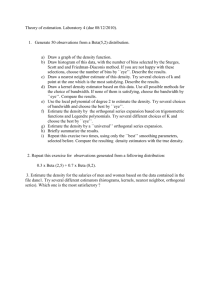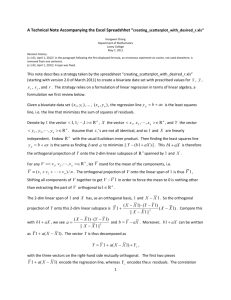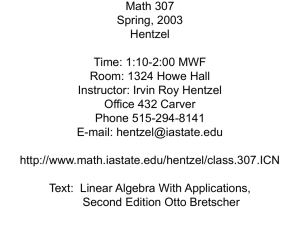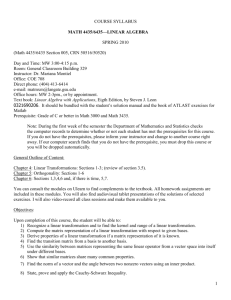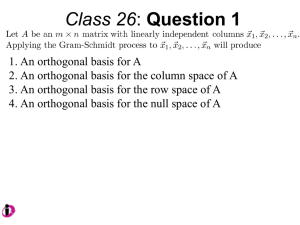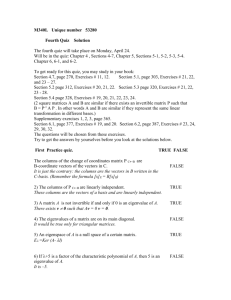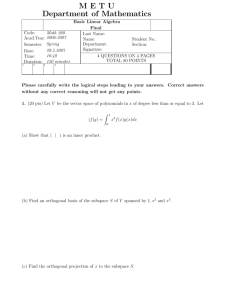A Journey of Discovery: Orthogonal Matrices and Wireless
advertisement
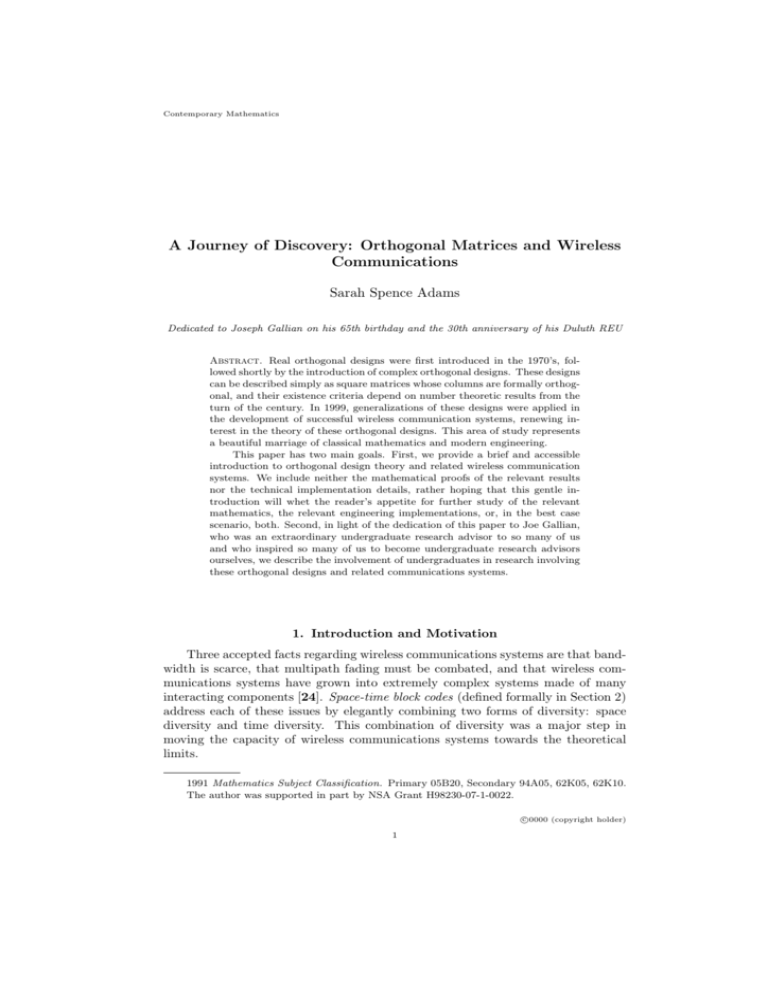
Contemporary Mathematics
A Journey of Discovery: Orthogonal Matrices and Wireless
Communications
Sarah Spence Adams
Dedicated to Joseph Gallian on his 65th birthday and the 30th anniversary of his Duluth REU
Abstract. Real orthogonal designs were first introduced in the 1970’s, followed shortly by the introduction of complex orthogonal designs. These designs
can be described simply as square matrices whose columns are formally orthogonal, and their existence criteria depend on number theoretic results from the
turn of the century. In 1999, generalizations of these designs were applied in
the development of successful wireless communication systems, renewing interest in the theory of these orthogonal designs. This area of study represents
a beautiful marriage of classical mathematics and modern engineering.
This paper has two main goals. First, we provide a brief and accessible
introduction to orthogonal design theory and related wireless communication
systems. We include neither the mathematical proofs of the relevant results
nor the technical implementation details, rather hoping that this gentle introduction will whet the reader’s appetite for further study of the relevant
mathematics, the relevant engineering implementations, or, in the best case
scenario, both. Second, in light of the dedication of this paper to Joe Gallian,
who was an extraordinary undergraduate research advisor to so many of us
and who inspired so many of us to become undergraduate research advisors
ourselves, we describe the involvement of undergraduates in research involving
these orthogonal designs and related communications systems.
1. Introduction and Motivation
Three accepted facts regarding wireless communications systems are that bandwidth is scarce, that multipath fading must be combated, and that wireless communications systems have grown into extremely complex systems made of many
interacting components [24]. Space-time block codes (defined formally in Section 2)
address each of these issues by elegantly combining two forms of diversity: space
diversity and time diversity. This combination of diversity was a major step in
moving the capacity of wireless communications systems towards the theoretical
limits.
1991 Mathematics Subject Classification. Primary 05B20, Secondary 94A05, 62K05, 62K10.
The author was supported in part by NSA Grant H98230-07-1-0022.
c
°0000
(copyright holder)
1
2
SARAH SPENCE ADAMS
A certain class of space-time block codes, known as complex orthogonal spacetime block codes, are built using mathematical constructs known as generalized
complex orthogonal designs. Orthogonal designs were first introduced in the mid1970’s [10, 12, 13, 14], however, mathematical results in other contexts dating
from the 1890’s laid the foundation for these combinatorial structures [1, 2, 3,
16, 17, 23]. The application of orthogonal designs and their generalizations as
as complex orthogonal space-time block codes has been successful. For example,
these codes are used in the Third Generation Mobile Standard and the proposed
standard for wireless LANs IEEE 802.11n.
Our introductory overview of complex orthogonal space-time block codes does
not attempt to match the technical rigor or completeness of Calderbank and Naguib’s
survey on this topic [7]. We refer the reader to their survey, as well as to the other
articles in the bibliography, for a more advanced treatment of the relevant mathematics and implementation details. The books by Jafarkhani [18] and Larsson and
Stoica [20] provide particularly comprehensive treatments of the topic.
In Section 2, we provide the necessary definitions and background information.
In Section 3, we discuss the two main research problems in this area, including a
narrative journey of undergraduate involvement in the solution of one of these main
problems. Section 4 provides a brief overview of other related research problems.
The paper is concluded in Section 5.
2. Definitions and Preliminaries
In modern wireless communication systems, data are sent from one or more
transmit antennas to one or more receive antennas. In this paper, we consider
one model for sending data over fading channels using multiple transmit antennas
and one or more receive antennas. The motivation for using multiple transmit
antennas is that multiple copies of data sent from different physical positions may
be corrupted in different ways during transmission, which may better allow the
receiver to recover the intended data. In other words, through appropriate signal
processing at the receiver, the independent paths provided by the multiple transmit
antennas can be considered as one channel that is more reliable than any of the
single independent paths. This idea is known as space diversity. The model we
consider also sends multiple copies of data at different timesteps, again increasing
the likelihood that the receiver can recover the intended data. This idea is known
as time diversity. Space and time diversity are explained in more depth in several
of our references, e.g., [7, 18, 20]. In the model that we consider, the data (or
signals) sent between antennas are modelled using complex variables.
In the most general form, a space-time block code for n transmit antennas is a
mapping from k complex variables {z1 , . . . , zk } onto an r × n matrix G, wherein
each of the n columns of G represents the transmissions of a distinct antenna and
each of the rows represents the transmissions at a given timestep. The entries in
the matrix determine which antenna should send which signal at which time, so
that an entry of zl in position (i, j) indicates that the signal corresponding to the
complex variable zl should be transmitted by the j th antenna in the ith timestep.
An entry of 0 indicates that the corresponding antenna does not transmit during
the corresponding timestep. As the number of rows r represents the number of
timesteps required to send the given data, and as this model requires us to receive
all of the data before we can decode, r is referred to as the decoding delay of the
A JOURNEY OF DISCOVERY: ORTHOGONAL MATRICES AND WIRELESS COMMUNICATIONS
3
code. The ratio k/r of number of distinct variables to the number of rows is a
measure of the code’s efficiency, and this is referred to as the rate of the code.
Complex orthogonal space-time block codes (COSTBCs) require that the matrix
G is a generalized complex orthogonal design, the formal definition of which we will
develop below. Qualitatively, COSTBCs require that the columns of the matrix
G are orthogonal, and it is this orthogonality (in part) that makes COSTBCs
attractive in practice: The orthogonality permits a simple maximum-likelihood
decoding algorithm which, through only linear combining at the receiver, decouples
the signals transmitted from the multiple antennas [29]. These codes also achieve
full diversity [29].
Real orthogonal designs were first defined and studied by Geramita, Geramita,
and Seberry Wallis [10, 12, 13, 14]:
Definition 2.1. A real orthogonal design of order n and type (s1 , s2 , . . . , sk )
(sl > 0) in real commuting variables x1 , x2 , . . . , xk , is an n × n matrix A with
entries from the set {0, ±x1 , ±x2 , . . . , ±xk } satisfying
AAT = AT A =
k
X
sl x2l In ,
l=1
where In is the n × n identity matrix.
The generalization to the complex domain followed shortly thereafter [9]:
Definition 2.2. A complex orthogonal design of order n and type (s1 , s2 , . . . , sk )
(sl > 0) in real commuting variables x1 , x2 , . . . , xk , is an n×n matrix C with entries
in the set {0, ±x1 , ±x2 , . . . , ±xk , ±ix1 , ±ix2 , . . . , ±ixk } satisfying
CH C =
k
X
sl x2l In ,
l=1
where H is the Hermitian transpose (the transpose complex conjugate) and i2 = −1.
An alternative definition for a complex orthogonal design C has entries from the
set {0, ±z1 , . . . , ±zk , ±z1∗ , . . . , ±zk∗ }, where the zl are complex commuting variables
and zl∗ denotes the complex conjugate of zl , such that
CH C =
k
X
sl |zl |2 In .
l=1
This latter definition is commonly used in the signal processing literature for its
application to space-time block codes [21, 22, 29].
Example 2.3. The following matrix C is a complex orthogonal design on complex variables z1 and z2 , using the latter definition above:
µ
¶
z1 z2
C=
−z2∗ z1∗
In fact, this simple complex orthogonal design was the first to be employed as a
space-time block code: The application was presented by Alamouti in 1998 [5].
(Alamouti himself did not refer to his code as a space-time block code, as that
term was coined later by Tarokh, Jafarkhani, and Calderbank [29].) Alamouti [5]
presented a very simple maximum-likelihood decoding scheme for this code, later
4
SARAH SPENCE ADAMS
reviewed and generalized by Tarokh et al. [29], that hinges on the orthogonality of
the columns of C.
Classical results from the turn of the century [1, 2, 3, 16, 17, 23] have been
shown to imply that real and complex orthogonal designs exist only for limited
values of n. The mathematics literature refers to the existence problem for orthogonal designs as the Hurwitz-Radon problem [11], and the results utilize the
Hurwitz-Radon function [26], also referred to in the mathematics literature as the
Radon-Hurwitz numbers [2, 6] or the Hurwitz-Radon-Eckmann formula [8, 25].
We recall the following definitions:
Definition 2.4. A set of n × n real matrices {B1 , B2 , . . . , Bm } is called a size
m Hurwitz-Radon family of matrices if BTi Bi = In and BTi = −Bi for all 1 ≤ i ≤ m
and if Bi Bj = −Bj Bi for all 1 ≤ i < j ≤ m.
Definition 2.5. Let n = 2a b, b odd, and write a = 4c + d where 0 ≤ d < 4.
Radon’s function is the arithmetic function ρ(n) = 8c + 2d .
Radon showed that a Hurwitz-Radon family of n × n matrices contains strictly
less than ρ(n) matrices, with the bound of n − 1 matrices being achieved if and only
if n = 2, 4, or 8 [23]. Tarokh et al. provide the details showing the equivalence of
Radon’s result to the fact that real orthogonal designs of order n exist only for n
= 2, 4, or 8 [29], assuming all entries in the design are nonzero. An extension of
this result shows that complex orthogonal designs of order n exist only for n = 2,
assuming all entries in the design are nonzero [29]. Liang also provides a detailed
summary of Hurwitz-Radon theory in the context of his treatment of real orthogonal
designs [21].
Another connection between real orthogonal designs and Hurwitz-Radon theory
was provided by Geramita, Geramita, and Seberry Wallis in their answer to the
fundamental question concerning the maximum number of variables permissable
in an n × n real orthogonal design. In particular, they showed that the number
of variables in an n × n real orthogonal design is less than or equal to ρ(n) [10].
Additionally, Calderbank and Naguib summarize certain connections among the
rate of real orthogonal designs, Hurwitz-Radon theory, amicable orthogonal designs,
and Clifford algebras [7].
Tarokh et al. recognized that Alamouti’s successful coding scheme based on
the matrix C given in Example 2.3 could be generalized by employing more general
matrices with mutually orthogonal columns. Due to the severe limitations on the
sizes of orthogonal designs and upon realizing the potential for utilizing orthogonal
designs in wireless communications systems, Tarokh et al. [29] defined generalized,
or rectangular, complex orthogonal designs as follows:
Definition 2.6. A generalized complex orthogonal design (GCOD) of order n
is an r × n matrix G with entries from {0, ±z1 ,. . . , ±zk , ±z1∗ , . . . , ±zk∗ }, or products
of these complex indeterminants with the imaginary unit i, such that
GH G =
k
X
|zl |2 In .
l=1
If the entries of G are allowed to be complex linear combinations of the complex
variables and their conjugates, then the design G is called a generalized complex
linear processing orthogonal design.
A JOURNEY OF DISCOVERY: ORTHOGONAL MATRICES AND WIRELESS COMMUNICATIONS
5
Using a well-known normalization result [29], it is assumed throughout that
each column of a generalized complex orthogonal design includes exactly one position occupied by ±zl or ±zl∗ , for each 1 ≤ l ≤ k and each row includes at most
one position occupied by ±zl or ±zl∗ , for each 1 ≤ l ≤ k. Geramita and Seberry
provide a comprehensive reference on orthogonal designs [11], and Liang reviews
and defines all of the relevant generalizations [22].
By extending the definition of a complex orthogonal design from the square
case to the rectangular case, Tarokh et al. were able to consider orthogonal matrices for any numbers of columns. In turn, this allowed the development of a theory
for complex orthogonal space-time block codes for any number of antennas [29]. As
with the Alamouti code [5], the columns of these rectangular designs are orthogonal, and hence the associated codes enjoy a simple decoding algorithm [7, 29].
Furthermore, these rectangular codes provide full transmit diversity and increase
the capacity of wireless channels [7, 29].
3. Important Parameters: Maximum Rate and the Road to Minimum
Delay
As with any combinatorial structure, there are natural optimization questions
to ask concerning orthogonal designs. We discussed above the question of how
many variables can be included in an n × n real orthogonal design. This question
is generalized as follows: What is the maximum rate (ratio of number of variables
to number of rows) achievable by a GCOD with n columns? A complementary
question, known as the “fundamental problem for generalized complex orthogonal
designs [29],” is as follows: What is the minimum decoding delay achievable by a
maximum rate generalized complex orthogonal design with n columns?
Taken together, we see that the overarching goal for any number of columns is
to arrange as many variables as possible into as few rows as possible. In other words,
for any number of transmit antennas, we would like to send as many distinct signals
as possible in the shortest possible amount of time. Of course, this optimization is
subject to the orthogonality constraint on the columns.
Liang answered the first main research question by proving that GCODs with
2m − 1 or 2m columns have the same maximum rate of m+1
2m , where m is any
natural number [21]. Furthermore, Liang provided an algorithm for constructing
maximum rate GCODs for any number of columns [21]. Several other authors
also worked towards determining the maximum rate and developing algorithms to
produce high-rate GCODs [28, 31, 32].
Liang’s result was hot off the press when I became interested in orthogonal
designs and their associated codes, thus it was clear that I should tackle the question
on minimum decoding delay. At that time, the only cases for which the minimum
delay was known were the trivial cases of 2, 3, and 4 columns, the cases of 5 and 6
columns addressed by Liang [21], and the cases of 7 and 8 columns addressed by
Kan and Shen [19]. The arguments for these cases were specialized to the number
of columns, and thus could not be elegantly generalized.
My initial strategy was to focus on the combinatorial structure of maximum rate
codes, hoping to exploit any found patterns and/or substructures. As I can tend
to be old-fashioned, I began with a by-hand analysis of all known maximum rate
GCODs. I looked for hidden patterns by printing out examples, literally cutting and
taping rows and columns in different orders, and using colored highlighters to track
6
SARAH SPENCE ADAMS
various variables. Indeed, this “arts and crafts project” led to the identification
of beautiful patterns and substructures within the maximum rate GCODs. The
next challenge, of course, was to determine which patterns and substructures were
significant and what they might imply about the minimum delay. This challenge
was compounded by the size of the matrices under consideration: Even a “small”
example has 8 columns and 112 rows, and every possible permutation of rows and
columns ought to have been considered. It was clearly time to turn to computational
power, a perfect project for undergraduate research students.
As luck would have it, just around this time, two Olin sophomores Nathan
Karst and Jon Pollack came into my office looking for some advice on choosing a
topic for their course project in my Discrete Mathematics class. (For the record,
I believe their project proposal was due the next day.) These students were talented programmers, and I suggested that they implement Liang’s new algorithm for
maximum rate GCODs and create software to manipulate the generated designs. I
showed them what I had been doing by hand: The avid programmers were horrified
that I would do such work manually, and they left my office motivated to create
software to automate all of my pattern-searching actions. Soon, they were hooked
on the excitement of working on unsolved problems, and they became my research
partners for the rest of their undergraduate careers (and beyond, in the case of
Karst).
The new (and constantly evolving) software allowed us to generate examples
larger than those previously available, which allowed us to test our hypotheses on
larger sets of data. Even more importantly, the software allowed us to quickly
reconfigure particular examples to identify additional patterns and substructures.
We ultimately focused on the zero patterns of the rows in the maximum rate designs.
A key observation was that every possible pattern of m − 1 zeros in a row of length
2m seemed to appear in at least one row of any maximum rate GCOD with 2m
columns. Linear algebraic and combinatorial arguments were employed to prove
that this observation holds. This then led naturally to the result that a lower
¡bound
¢ on the decoding delay for a maximum rate GCOD with 2m columns is
2m
m−1 [4]. We later extended this result to hold for the case of 2m − 1 columns [4].
Naturally, we then needed to determine if our bound was tight. For the cases
of 2m − 1 columns and 2m columns with m even, an algorithm already existed to
generate maximum rate codes that happened to achieve the lower bound on delay
[28]. For the case of 2m columns with m odd, however, no such algorithms existed.
In fact, all known algorithms for maximum rate GCODs generated examples that
achieved twice our lower bound on delay when the number of columns was 2m for m
odd [21, 28]. Also, Liang had proven that for the case of 6 columns, the minimum
decoding delay was 30, or twice our lower bound [21].
This case of 2m columns with m odd was elusive for quite a while, although we
did have an early success in proving that if such a GCOD does not meet the lower
bound, then it can at best meet twice the lower bound. Since algorithms did exist
that happened to generate maximum rate codes that meet twice the lower bound
in this case [21, 28], we were left to prove that GCODs in this case cannot achieve
the lower bound.
After months of analysis, it became clear that we needed some new tools to
attack this final case of 2m columns for m odd. Several new undergraduate research
students had rotated through the group during this time, two of whom, Alex Dorsk
A JOURNEY OF DISCOVERY: ORTHOGONAL MATRICES AND WIRELESS COMMUNICATIONS
7
and Andy Kalcic, helped developed a theory connecting GCODs to signed graphs,
which are graphs whose edges are assigned weights of -1 or 1. Unfortunately, the
restatement in terms of signed graphs turned out to be an unsolved problem studied
(and known to be difficult) by graph theorists. However, this new paradigm allowed
for new methods of attack, and it pleased me that my students were learning to
initiate creative approaches to the problem.
In the end, the beast was tackled using a combination of combinatorial analysis,
the signed graph paradigm, and a linear algebraic technique that was developed primarily by another undergraduate, Mathav Kishore Murugan, who was visiting me
as a summer research student from the Indian Institute of Technology in Kharagpur,
India. This was truly a collaborative effort, involving contributions from several
undergraduates with complementary strengths and interests. The final result was
as expected: For a maximum¡rate ¢GCOD with 2m columns for m odd, the best
2m
achievable decoding delay is 2 m−1
, or twice the lower bound.
Related results came as corollaries to our main work on minimum decoding
delay. For example, we showed
¡ that
¢ a maximum rate GCOD with 2m − 1 or 2m
columns must utilize at least 12 2m
m variables, with this bound being tight for 2m−1
columns and 2m columns for m even. Similar to the result on minimum decoding
delay, for the case of 2m columns
¡ with
¢ m odd, the minimum required number of
variables is twice this bound, or 2m
m [4].
4. Additional Research Topics
4.1.
Rate 1/2 Complex Orthogonal Designs. The minimum delay of
¢
for a maximum rate GCOD with 2m − 1 or 2m columns grows quickly with
respect to the number of columns. This suggests that non-rate-optimal GCODs
may be preferable in practice (or more interesting in theory), as the decoding delay
is prohibitively large in maximum rate GCODs with large numbers of columns. It is
known that the maximum rate of GCODs with 2m − 1 or 2m columns is m+1
2m [21],
which approaches 1/2 as the number of columns increases. Hence there are two
natural questions to ask: What is the minimum decoding delay for rate 1/2 codes?
Would the sacrifice in rate be worth the trade-off for a smaller decoding delay?
While these two questions are motivated by the application of designs to coding
systems, the first question in particular reveals some interesting mathematics.
Several undergraduates have been involved in the effort to determine the minimum decoding delay of rate 1/2 GCODs, including Matthew Crawford, Caitlin
Greeley, Nathan Karst, Mathav Kishore Murugan, and Bryce Lee. Our current
work indicates that the minimum delay for a rate 1/2 GCOD with 2m − 1 or 2m
columns is 2m−1 or 2m , depending on the number of columns modulo 8. Although
this delay is significantly smaller than the delay for maximum rate codes, it still
grows exponentially.
It remains to examine the performance of these rate 1/2 codes, and it remains
to answer whether we can slightly decrease the rate below 1/2 in order to gain a
significant savings on decoding delay.
¡
2m
m−1
4.2. Conjugation Patterns and Transceiver Signal Linearization. As
is often the case, a question that seems to have only theoretical importance turns out
to have practical significance as well. During our work determining the minimum
decoding delay for maximum rate generalized complex orthogonal designs, we began
to notice a connection between whether a given design met the bound on decoding
8
SARAH SPENCE ADAMS
delay and whether it was possible to arrange the matrix using equivalence operations
so that every nonzero entry in a given row was either conjugated or non-conjugated.
We studied various patterns of conjugation mostly out of mathematical curiosity,
however this property is also useful in the application of these designs as COSTBCs.
Certain COSTBCs enjoy a property known as transceiver signal linearization,
which can facilitate decoding: This linearization allows the code to be backward
compatible with existing signal processing techniques and standards, and it allows
for the design of low complexity channel equalizers and interference suppressing
filters [27]. It has been shown that a COSTBC can achieve transceiver signal
linearization if each row in the code has either all conjugated entries or all nonconjugated entries [27], which is precisely the property we analyzed while looking
for mathematical patterns in the underlying designs.
We have been able to show that if a maximum rate COSTBC
¡ 2m has
¢ an odd
number of columns 2m − 1 and achieves the minimum delay of m−1
or has an
¡ 2m ¢
even number of columns 2m and achieves twice the minimum delay 2 m−1
, then
transceiver signal linearization is achievable. If a maximum rate COSTBC has an
even number of columns 2m and achieves the minimum delay, then transceiver
signal linearization is not possible.
This work highlights the fact that trade-offs are omnipresent when designing
a communication system. For example, there are maximum rate COSTBCs with
2m ≡ 0 (mod 4) columns that achieve transceiver signal linearization, and there
are such codes that achieve the lower bound on decoding delay, but no such code
can achieve both properties simultaneously.
Our current work examines which rate 1/2 COSTBCs can achieve transceiver
signal linearization, and again the work indicates that the answer depends on the
number of columns modulo 8.
5. Conclusions
This paper has provided a gentle introduction to orthogonal designs and their
application as complex orthogonal space-time block codes. We have reviewed the
major results of both theoretical and practical importance regarding these designs/codes, presenting the maximum rate as determined by Liang and providing
a narrative of the determination of the minimum decoding delay by this author
working with an army of undergraduates. We have also briefly described certain
related research topics, including some open problems.
Recent breakthroughs in antenna technology [15, 30] and a growing interest
in distributed systems contribute to a growing interest in determining the optimal
trade-off between rate and delay for COSTBCs with arbitrary numbers of antennas.
However, we must note that it is only for two antennas that we can simultaneously
achieve full rate, square size (meaning lowest possible delay), and transceiver linearization. As the number of antennas increases, there is a sacrifice in some or all
of these parameters. The analysis of such trade-offs is at the core of the challenge
of designing wireless communication systems.
Acknowledgements
I would like to thank all of the undergraduates who have done research with me
on complex orthogonal space-time block codes, as well as those who have conducted
preliminary research on orthogonal designs defined over the quaternion domain in
A JOURNEY OF DISCOVERY: ORTHOGONAL MATRICES AND WIRELESS COMMUNICATIONS
9
a quest to develop a new class of space-time-polarization block codes: Herbert
Chang, Matthew Crawford, Alex Dorsk, Caitlin Greeley, Andy Kalcic, Nathan
Karst, Mathav Kishore Murugan, Bryce Lee, David Nelson, Aaron Peterson, Jon
Pollack, and Russell Torres. Special thanks go to my first two undergraduate
research students, Nathan Karst and Jon Pollack, who worked with me for three
years until I had to let them graduate. I expect that many of these students will
continue in the legacy of Joe Gallian and become undergraduate research advisors
themselves.
I would also like to thank Jennifer Seberry for sparking my initial interest in
combinatorial designs and their related codes.
References
[1] J. F. Adams. Vector fields on spheres. Ann. of Math. (2), 75:603–632, 1962.
[2] J. F. Adams, P. D. Lax, and R. S. Phillips. On matrices whose real linear combinations are
non-singular. Proc. Amer. Math. Soc., 16:318–322, 1965.
[3] J. F. Adams, P. D. Lax, and R. S. Phillips. Correction to “On matrices whose real linear
combinations are nonsingular”. Proc. Amer. Math. Soc., 17:945–947, 1966.
[4] S. Adams, N. Karst, and J. Pollack. The minimum decoding delay of maximum rate complex
orthogonal space-time block codes. IEEE Trans. Inform. Theory, 53(8):2677–2684, 2007.
[5] S. M. Alamouti. A simple transmit diversity technique for wireless communications. IEEE
Journal on Selected Areas in Communications, 16(8):1451–1458, 1998.
[6] M. A. Berger and S. Friedland. The generalized Radon-Hurwitz numbers. Compositio Math.,
59(1):113–146, 1986.
[7] A. R. Calderbank and A. F. Naguib. Orthogonal designs and third generation wireless communication. In Surveys in combinatorics, 2001 (Sussex), volume 288 of London Math. Soc.
Lecture Note Ser., pages 75–107. Cambridge Univ. Press, Cambridge, 2001.
[8] B. Eckmann. Gruppentheoretischer Beweis des Satzes von Hurwitz-Radon über die Komposition quadratischer Formen. Comment. Math. Helv., 15:358–366, 1943.
[9] A. V. Geramita and J. M. Geramita. Complex orthogonal designs. J. Combin. Theory Ser.
A, 25(3):211–225, 1978.
[10] A. V. Geramita, J. M. Geramita, and J. S. Wallis. Orthogonal designs. Linear and Multilinear
Algebra, 3(4):281–306, 1975/76.
[11] A. V. Geramita and J. Seberry. Orthogonal designs, volume 45 of Lecture Notes in Pure and
Applied Mathematics. Marcel Dekker Inc., New York, 1979. Quadratic forms and Hadamard
matrices.
[12] A. V. Geramita and J. S. Wallis. Orthogonal designs. III. Weighing matrices. Utilitas Math.,
6:209–236, 1974.
[13] A. V. Geramita and J. S. Wallis. Orthogonal designs. II. Aequationes Math., 13(3):299–313,
1975.
[14] A. V. Geramita and J. S. Wallis. Orthogonal Designs. IV. Existence questions. J. Combinatorial Theory Ser. A, 19:66–83, 1975.
[15] B. N. Getu and J. B. Andersen. The MIMO cube: A compact MIMO antenna. IEEE Trans.
Wireless Commun., 4:1136–1141, 2005.
[16] A. Hurwitz. Uber die komposition der quadratischen formen von beliebig vielen variablem.
Nachr. Gesell. d. Wiss. Gottingen, pages 309–316, 1898.
[17] A. Hurwitz. Uber die komposition der quadratischen formen. Math. Ann., 88(5):1–25, 1923.
[18] H. Jakarhami. Space-time coding theory and practice. Cambridge University Press, Cambridge, 2005.
[19] H. Kan and H. Shen. A counterexample for the open problem on the minimal delays of
orthogonal designs with maximal rates. IEEE Trans. Inform. Theory, 51(1):355 – 359, 2005.
[20] E. G. Larsson and P. Stoica. Space-time block coding for wireless communications. Cambridge
University Press, Cambridge, 2003.
[21] X.-B. Liang. Orthogonal designs with maximal rates. IEEE Trans. Inform. Theory,
49(10):2468–2503, 2003. Special issue on space-time transmission, reception, coding and signal processing.
10
SARAH SPENCE ADAMS
[22] X.-B. Liang and X.-G. Xia. On the nonexistence of rate-one generalized complex orthogonal
designs. IEEE Trans. Inform. Theory, 49(11):2984–2989, 2003.
[23] J. Radon. Lineare scharen orthogonaler matrizen. Abhandlungen aus dem Mathematischen
Seminar der Hamburgischen Universitat, pages 1–14, 1922.
[24] T. Rappaport. Wireless communications: Principles and Practice, Second Edition. Prentice
Hall, New York, 1993, 2001.
[25] J. T. Schwartz. Differential Geometry and Topology. Gordon and Breach, New York, 1968.
[26] D. B. Shapiro. Compositions of quadratic forms, volume 33 of de Gruyter Expositions in
Mathematics. Walter de Gruyter & Co., Berlin, 2000.
[27] W. Su, S. N. Batalama, and D. A. Pados. On orthogonal space-time block codes and
transceiver signal linearization. IEEE Communications Letters, 8(60):458–460, 2004.
[28] W. Su, X.-G. Xia, and K. J. R. Lui. A systematic design of high-rate complex orthogonal
space-time block codes. IEEE Communications Letters, 8(6):380 – 382, 2004.
[29] V. Tarokh, H. Jafarkhani, and A. R. Calderbank. Space-time block codes from orthogonal
designs. IEEE Trans. Inform. Theory, 45(5):1456–1467, 1999.
[30] C. Waldschmidt and W. Wiesbeck. Compact wide-band multimode antennas for MIMO and
diversity. IEEE Trans. Antennas Propagat., 52:1963–1969, 2004.
[31] H. Wang and X.-G. Xia. Upper bounds of rates of complex orthogonal space-time block codes.
IEEE Trans. Inform. Theory, 49(10):2788 – 2796, 2003.
[32] C. Xu, Y. Gong, and K.B. Letaief. High-rate complex orthogonal space-time block codes for
high number of transmit antennas. 2004 IEEE International Conference on Communications,
2:823 – 826, 2004.
Franklin W. Olin College of Engineering, Needham, MA 02492, USA
E-mail address: sarah.adams@olin.edu

